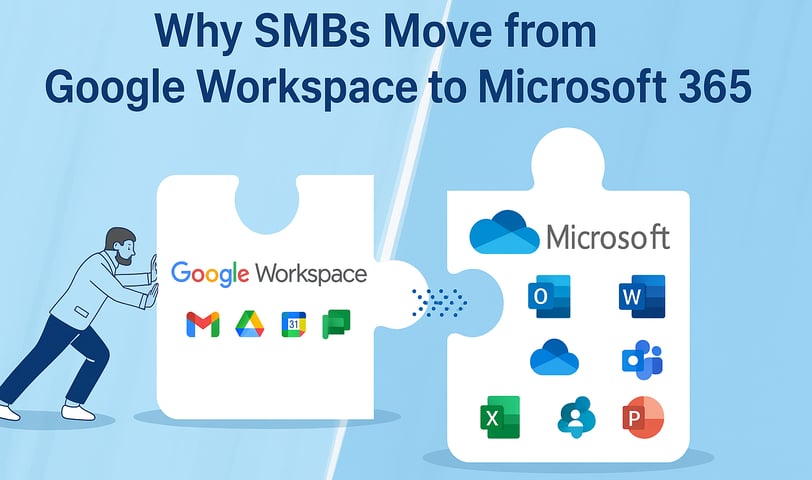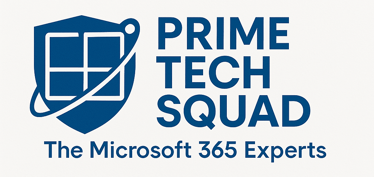Why Growing SMBs Are Transitioning from Google Workspace to Microsoft 365
Is Your Business Outgrowing Google Workspace? As SMBs scale, so do their needs for stronger security, deeper integrations, and more powerful tools. Discover why thousands of growing businesses are making the move to Microsoft 365—and how it better supports complex workflows, compliance, and productivity. Read the full blog to learn what’s driving this shift and how to transition seamlessly.
Hasmukh Solanki
7/7/20252 min read


In the early stages of business growth, simplicity is everything. That’s why many small and medium-sized businesses (SMBs) across the globe choose Google Workspace. It’s affordable, intuitive, and packed with the basic tools needed to get started—Gmail, Google Docs, Drive, Calendar, and Meet.
But as these companies expand, their needs evolve.
With more employees, growing teams, compliance demands, and increasingly complex workflows, many SMBs find themselves outgrowing Google Workspace. That’s when they begin looking for a more robust platform—and for many them, the answer is Microsoft 365.
Why SMBs Start with Google Workspace
Google Workspace (formerly G Suite) makes perfect sense for small teams:
Easy setup and onboarding
Real-time collaboration in Docs, Sheets, and Slides
Simple file sharing through Google Drive
A clean, cloud-first approach
It's ideal for startups and lean teams who prioritize speed and cost-efficiency. But eventually, the platform starts to show limitations, particularly in areas like security, integration with desktop tools, advanced workflows, and IT administration.
Why Businesses Migrate to Microsoft 365
As operations grow more complex, Microsoft 365 becomes the platform of choice. Here’s why so many SMBs are making the switch:
1. Powerful Desktop + Cloud Experience
Many teams still rely heavily on desktop apps like Excel, Word, and PowerPoint—and the online versions just aren’t enough. Microsoft 365 offers:
Full-featured desktop applications
Offline access with automatic cloud sync
Seamless file compatibility and formatting
This hybrid approach supports both in-office and remote users without compromise.
2. Enterprise-Grade Security and Compliance
Security becomes a bigger priority as teams grow. Microsoft 365 offers:
Data Loss Prevention (DLP) and Information Rights Management (IRM)
Advanced email protection with Microsoft Defender
Compliance Manager for industry-specific regulations
Multi-Factor Authentication (MFA) and Conditional Access policies
These tools give growing businesses confidence that their data is protected and compliant—something Google Workspace often lacks at the same depth.
3. Advanced Email with Exchange Online
Email remains the lifeline of business communication. Exchange Online in Microsoft 365 provides:
Shared mailboxes, aliases, and retention policies
Robust calendar and resource booking tools
Built-in compliance features for legal holds and auditing
For teams handling high volumes of email or working in regulated industries, Microsoft 365 delivers the control they need.
4. Integrated Identity & Access Management
Microsoft 365 integrates tightly with Azure Active Directory (Azure AD), enabling:
Centralized user and group management
Role-based access control
Single Sign-On (SSO) to thousands of SaaS apps
Secure device and user policies
This makes it easier for IT admins to manage users at scale and enforce security across the organization.
5. Productivity Tools Beyond the Office Suite
Microsoft 365 doesn’t stop at Word and Excel. It includes:
Microsoft Teams – A centralized hub for chat, meetings, file sharing, and more
SharePoint Online – For intranets, document libraries, and workflow automation
OneDrive for Business – 1 TB+ per user of secure file storage
Loop, Planner, and To Do – Tools for modern collaboration and task management
These tools replace fragmented workflows with integrated systems.
6. Automation & Intelligence with Power Platform
Microsoft 365 gives businesses access to the Power Platform:
Power Automate – Build automated workflows across apps
Power BI – Turn data into visual insights and dashboards
Power Apps – Quickly build low-code apps for internal use
These capabilities unlock efficiency and help SMBs operate like much larger organizations—without the need for dedicated developers.
Final Thoughts
For many SMBs, Google Workspace is the perfect springboard. But as your company grows, so do your expectations around productivity, security, and collaboration. Microsoft 365 is designed to meet those evolving needs head-on.
Whether it’s the powerful Office desktop suite, enterprise-grade security, or advanced tools for automation and compliance, Microsoft 365 offers a scalable platform that keeps up with your business
